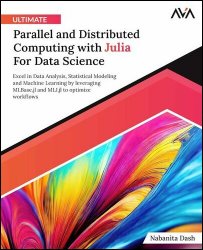 Название
Название: Ultimate Parallel and Distributed Computing with Julia For Data Science: Excel in Data Analysis, Statistical Modeling and Machine Learning by Leveraging MLBase.jl and MLJ.jl to Optimize Workflows
Автор: Nabanita Dash
Издательство: Orange Education Pvt Ltd, AVA
Год: 2024
Страниц: 484
Язык: английский
Формат: epub (true)
Размер: 10.1 MB
Unleash Julia’s power: Code Your Data Stories, Shape Machine Intelligence! This book takes you through a step-by-step learning journey, starting with the essentials of Julia's syntax, variables, and functions. You'll unlock the power of efficient data handling by leveraging Julia arrays and DataFrames.jl for insightful analysis. Develop expertise in both basic and advanced statistical models, providing a robust toolkit for deriving meaningful data-driven insights. The journey continues with Machine Learning proficiency, where you'll implement algorithms confidently using MLJ.jl and MLBase.jl, paving the way for advanced data-driven solutions. Explore the realm of Bayesian inference skills through practical applications using Turing.jl, enhancing your ability to extract valuable insights. The book also introduces crucial Julia packages such as Plots.jl for visualizing data and results. The handbook culminates in optimizing workflows with Julia's parallel and distributed computing capabilities, ensuring efficient and scalable data processing using Distributions.jl, Distributed.jl and SharedArrays.jl. This comprehensive guide equips you with the knowledge and practical insights needed to excel in the dynamic field of Data Science and Machine Learning. In this book, we embark on a journey that explores the powerful intersection of Julia, a high-performance programming language, and the transformative fields of machine learning and data analysis. As technology continues to evolve, the ability to harness and interpret vast amounts of data becomes increasingly crucial. Julia, with its speed, simplicity, and expressive syntax, emerges as an ideal language for tackling the challenges posed by the ever-growing datasets and complex algorithms in these domains.









